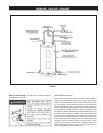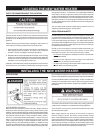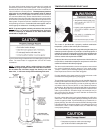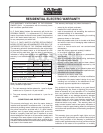
13
The water heater should be drained if being shut down during freezing
temperatures. Also periodic draining and cleaning of sediment from the
tank may be necessary.
1. Turn electrical supply “OFF”.
2. CLOSE the cold water inlet valve to the water heater.
3. OPEN a nearby hot water faucet and leave open to allow for
draining.
4. Connect a hose to the drain valve and terminate to an adequate
drain.
5. OPEN the water heater drain valve to allow for tank draining.
NOTE: If the water heater is going to be shut down and
drained for an extended period, the drain valve should be
left open with hose connected allowing water to terminate
to an adequate drain.
6. Close the drain valve.
7. Follow the instructions in the “Filling the Water Heater” section.
DRAIN VALVE WASHER REPLACEMENT
(See Figure 9)
1. Follow “Draining” instructions.
2. Turning counter clockwise (
), remove the hex cap below the
screw handle.
3. Remove the washer and put the new one in place.
4. Screw the handle and cap assembly back into the drain valve and
retighten using a wrench. DO NOT OVER TIGHTEN.
5. Follow instructions in the “Filling The Water Heater” section.
6. Check for leaks.
FIGURE 9.
SERVICE
If a condition persists or you are uncertain about the operation of the
water heater contact a service agency.
Use this guide to check a “Leaking” water heater. Many suspected
“Leakers” are not leaking tanks. Often the source of the water can be
found and corrected.
If you are not thoroughly familiar with your water heater and safety
practices, contact a qualified installer to check the water heater.
anode rod can extend the life of your water heater. Inspection should
be conducted by a qualified technician, and at a minimum should be
checked annually after the warranty period.
TEMPERATURE-PRESSURE
RELIEF VALVE OPERATION
The temperature-pressure relief valve must be manually operated at
least once a year.
When checking the temperature-pressure relief valve operation, make
sure that (1) no one is in front of or around the outlet of the temperature-
pressure relief valve discharge line, and (2) that the water discharge
will not cause any property damage, as the water may be extremely
hot, see Figure 8.
FIGURE 8.
If after manually operating the valve, it fails to completely reset and
continues to release water, immediately close the cold water inlet to
the water heater, follow the draining instructions, and replace the
temperature-pressure relief valve with a new one.
If the temperature-pressure relief valve on the appliance weeps or
discharges periodically, this may be due to thermal expansion. You
may have a check valve installed in the water line or a water meter
with a check valve. Consult your local water supplier or service
agency for further information. Do not plug the temperature-pressure
relief valve.
DRAINING


















